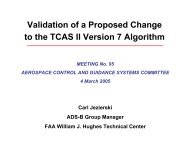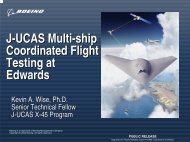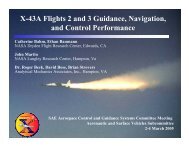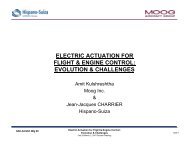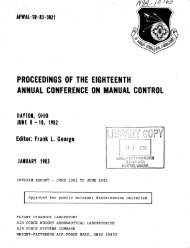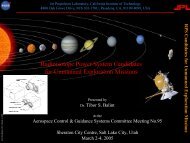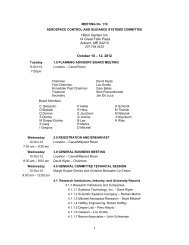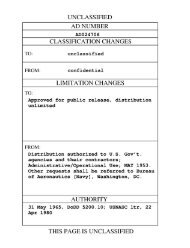Report of the Second Piloted Aircraft Flight Control System - Acgsc.org
Report of the Second Piloted Aircraft Flight Control System - Acgsc.org
Report of the Second Piloted Aircraft Flight Control System - Acgsc.org
Create successful ePaper yourself
Turn your PDF publications into a flip-book with our unique Google optimized e-Paper software.
with a control system actuated by a poner boost system. The syatsan we have<br />
considered is shown in Pig. 1. Our cgr6tam consi8ts basicaUy <strong>of</strong> five parts.<br />
Working from <strong>the</strong> stick to <strong>the</strong> control surface, from lef't to right on <strong>the</strong><br />
diagram, we have first a mechanical coupling system, between <strong>the</strong> stick and<br />
<strong>the</strong> hydraulic power qystem. k here represents <strong>the</strong> compliance <strong>of</strong> <strong>the</strong> push<br />
rod. or control cable from <strong>the</strong> stick to <strong>the</strong> input to <strong>the</strong> Wdraulic gyetm.<br />
The damper fp aad lnrrsr % represent <strong>the</strong> impedance seen looking into <strong>the</strong><br />
input to <strong>the</strong>-bdraulic Getem from <strong>the</strong> output d <strong>of</strong> <strong>the</strong> control cable. In<br />
our initial &udy <strong>of</strong> <strong>the</strong> qystm, ws have a 8 d that <strong>the</strong>se parameters are<br />
irdqandent <strong>of</strong> <strong>the</strong> gain <strong>of</strong> <strong>the</strong> Wdraulic system. I will have &re to say<br />
ooneerning <strong>the</strong>se oimplifying arsumptionr later.<br />
The inprt to <strong>the</strong> hydraulic system is <strong>the</strong> displacsmsnt xp.<br />
We consider<br />
a singlbstage maulic system, with an output displacement + actuating<br />
<strong>the</strong> bell crnk to give a deflaation <strong>of</strong> <strong>the</strong> control surface & . The normal,<br />
or vertical aeceletration <strong>of</strong> <strong>the</strong> airplane, n, is detarmined by this deflection<br />
through <strong>the</strong> aermcsl characteristics <strong>of</strong> <strong>the</strong> aircraft. The artificial<br />
fael ~8'km Vb is <strong>the</strong> 8-108t po88ibh8 COM~S~* OW <strong>of</strong> <strong>the</strong><br />
bobweight <strong>of</strong> mas8 rmnll n. We do nat Imply that this is at all typical <strong>of</strong><br />
general artificial feel ayrtaw. Certainly our system probably should<br />
include at least a spring. Howwer, we feel very strongly, as I shall txy<br />
to point out later, that <strong>the</strong> desis <strong>of</strong> a witable artificial feel qpstsm<br />
depends on consIdaration8 <strong>of</strong> dynamic &ability (and when I speak <strong>of</strong> stability,<br />
I refer to dpadc stability) and <strong>the</strong> nature and characteristics <strong>of</strong> <strong>the</strong> pilot<br />
in <strong>the</strong> closed loop system. We feel, and perhaps you will agree as wd continue,<br />
that this simple bobweight system suffices as an emample <strong>of</strong> <strong>the</strong> general<br />
prooeduree and ideas I hope to present to you. The introduction <strong>of</strong> a spring<br />
does not, for e~mple, materially change our development.<br />
Figures 2, 3, and 4 show <strong>the</strong> basic components <strong>of</strong> our syetem in more<br />
detail. Figure 2 shows <strong>the</strong> aerodynamic axes a& basic equations, Plg. 3<br />
<strong>the</strong> stick dynamics and Fig. 4 <strong>the</strong> hydraulic qystem. The pertinent equations<br />
accontparUr <strong>the</strong> figures. A considerable portion <strong>of</strong> <strong>the</strong> &fort <strong>of</strong> <strong>the</strong> Purdue<br />
group over <strong>the</strong> past year haa been spent in <strong>the</strong> aualyds <strong>of</strong> <strong>the</strong> bdraulic<br />
system, <strong>the</strong> development <strong>of</strong> measuring techniques and <strong>the</strong> correlation <strong>of</strong> valve<br />
configuration with static and dynamic characteristics. Homera today I would<br />
like to consider <strong>the</strong> hydraulic valve as described simply by <strong>the</strong> flav-proportionalto-displacement<br />
equation, which is an adequate deecription over <strong>the</strong> frequency<br />
range <strong>of</strong> interest to usa and oadt any detailed disoussion <strong>of</strong> o<strong>the</strong>r possible<br />
linear and nonlhear analytical descriptions <strong>of</strong> <strong>the</strong> system.<br />
Referring again to figure 1, ue see that <strong>the</strong>re are basically two feedback<br />
eystcms to be designed-<strong>the</strong> &draulic system, ach is a closed-loop, positional<br />
feedback ggstem, and <strong>the</strong> overall airplane control system which contains<br />
<strong>the</strong> 4ydrauU.c loop ao one co~lponent. OPT initial interest at Purdue was<br />
concentrated on <strong>the</strong> waulic system, but it rapidly became apparent that<br />
this one component could not be intelligently designed or andlysed without<br />
c~neideration <strong>of</strong> <strong>the</strong> overall qyatem. I mid like to speak briefly about <strong>the</strong><br />
stabilization <strong>of</strong> <strong>the</strong> maulic system and <strong>the</strong>n consider in more detail <strong>the</strong><br />
desi- <strong>of</strong> <strong>the</strong> overall loop.



